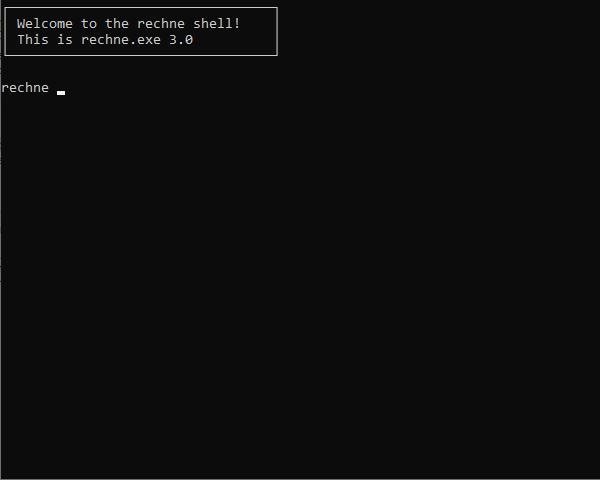rechne.exe
 Download rechne.exe
Version 3.1 • English • Windows (64 Bit)
All files and versions
Download rechne.exe
Version 3.1 • English • Windows (64 Bit)
All files and versions
Features
|  |
Options
-v | Verbosity: print all intermediate steps. Example: rechne -v 12+3*sin(1.5*Pi) |
-q | Quiet: only print the final result. Example: rechne -q 12+3*sin(1.5*Pi) |
-y | Force: answer all questions with yes. Example: rechne -y Pi=3.14 |
-p [x] | Precision: print numbers with [x] decimal places. Default is scientific (as many places as needed). Example: rechne -p5 Pi^2 |
-i [x] | Input numeral system (default is 10 → decimal numbers). Example: input binary number: rechne -i2 1101011100 |
-o [x] | Output numeral system (default is 10 → decimal numbers). Example: output hexadecimal number: rechne -o16 123456 |
-o polar | Print complex numbers in polar format (default is arithmetic format). Example: rechne -opolar sqrt(-4)+3 |
The options can be combined.
Example: take binary numbers as input, output as hexadecimal numbers and print all intermediate steps:
rechne -i2 -o16 -v (11101-111)^10
11101 -> 29
111 -> 7
10 -> 2
29-7 = 22
22^2 = 484
484 -> 1E4
Result: 1E4
Supported functions/operations
| modulus | mod | factorial | fac | raising | ^ |
| shift decimal point | E | root | rt | square root | sqrt |
| logarithm | log | natural logarithm | ln | decimal logarithm | lg |
| binary logarithm | ld | parallel operation | // | binominal coefficient | binom |
| sinc function | si | sine | sin | cosine | cos |
| tangent | tan | secant | sec | cosecant | csc |
| cotangent | cot | arcsine | asin | arccosine | acos |
| arctangent | atan | arcsecant | asec | arccosecant | acsc |
| arccotangent | acot | hyperbolic sine | sinh | hyperbolic cosine | cosh |
| hyperbolic tangent | tanh | hyperbolic cotangent | coth | area hyperbolic sine | asinh |
| area hyperbolic cosine | acosh | area hyperbolic tangent | atanh | area hyperbolic cotangent | acoth |
| numerical integral | sum | product integral | prd | definite integral | int |
| random number | rand | fibonacci sequence | fib | signum function | sig |
| round-down | floor | round-up | ceil | real part | creal |
| imaginary part | cimg | absolute value | cabs | polar angle | carg |
| greatest real number | max | smallest real number | min | greatest magnitude | maxc |
| smallest magnitude | minc | greatest common divisor | gcd | least common multiple | lcm |
| factorization | factor | digit sum | ds | iterative digit sum | dsi |
| digit product | dp | iterative digit product | dpi | previous results | ANS |
| Pi | Pi | Eulers number | e | imaginary unit | i |
Example:
rechne sqrt ?
Big number mode
But some application (e.g. cryptography) require exact results. In this sense "big numbers" are only a stream of bytes. This is what the big number mode is for.
Type
rechne bn to enter the big number mode. By default all inputs are hexadecimal (upper case!).
Not all functions/operations from the default mode are implemented here. Type help to see
what functions/options are implemented.Big number options
-v | Verbosity: print all intermediate steps and print a memory & time usage summary at the end. Example: rechne@bn -v AFFE007|FF |
-p | Plain output: do not format the output numbers. Example: rechne@bn -p AFFE007 |
-q | Quiet: only print the final result. Example: rechne@bn -q AFFE007|FF |
-y | Force: answer all questions with yes. Example: rechne@bn -y rand(8000) |
-s [file] | Save the resulting big number to a file with name [file]. In contrast to normal assignments the file will still be there, after rechne.exe has exited. Written numbers can be read with the read function. PLEASE NOTE: writing the file uses the currently set output format (by default hex). This format has to be used as input format when reading again.Example: rechne@bn -s myprime1 prime(100)rechne@bn read(myprime1) |
-i [x] | Input format where [x] can be one of
rechne@bn -i dec 6432876431526887987 |
-o [x] | Output format, same values for [x] possible as with -i. Example: output binary number: rechne@bn -o bin AFFE007 |
-f/-l [x] | Print the first or last [x] bytes of the big number only. Example: only print first 10 bytes of a large random number: rechne@bn -f 10 rand(1000) |
Big number functions
(a)mod(b) | Modulo: the rest of the division of two numbers 'a/b'. Example: rechne@bn AFFE007modABC |
(a)pow(b) | Exponentiation: raising 'a' to power 'b'. Example: rechne@bn AFFE007pow2 |
(a)pow(b)mod(c) | Exponentiation with Modulo: especially for use in RSA crypto. Example: rechne@bn AFFE007pow2modABC |
sqrt(a) | Square root of input number 'a' (Herons algorithm). Example: rechne@bn sqrt(AFFE007) |
rand(a) | Create a random number with 'a' bits. Example: rechne@bn -idec rand(1024) |
read(file) | Read a previously (with -s) written number from a file. |
gcd(a,b) | Greatest common divisor of two numbers 'a' and 'b'. Example: rechne@bn gcd(AFFE00C,ABC) |
mrt(a,b) | Miller-Rabin-Test: returns 1 if 'a' is a (probable) prime number, tested with coefficient b. Example: rechne@bn mrt(AFFE007,101) |
prime(a) | Find a prime number with 'a' bits. This will generate odd random numbers of size 'a' and apply the Miller-Rabin-Test. Example: rechne@bn -idec prime(1024) |
eea(a,b) | Find the multiplicative inverse of 'a mod b' using the extended Euklidean algorithm. Example: rechne@bn -idec eea(99,78) |
Sample snippets
Example 1: Convert a hexadecimal number to decimal:rechne@bn -o dec AFFE007Example 2: Get a prime number of size 1024 bits and save to local variable 'p':
rechne@bn p=prime(400) (why 400 and not 1024? Because ALL numbers are hexadecimal if not otherwise specified. So 1024(dec) = 400(hex) )PLEASE NOTE: generating big prime numbers may take some while and can heat up the CPU quite a bit. Many random numbers of the requested size are created and checked for primality (using the Miller-Rabin-Test), which is costly.
Example 3: Read a JPEG file and print the first 10 bytes:
rechne@bn -ix -f10 read(picture.jpg) ('-ix' tells the program to expect non-ASCII byte code)PLEASE NOTE: the '-f/-l' option only affects the printing of the big numbers but has no effect on the internal representation. So in the background the entire file is read and held as a big number.
Example 4: Write a hex number to binary file:
rechne@bn -ox AFFE007 > myfile ('-ox' tells the program to output non-ASCII byte code and '>' redirects all outputs to the file 'myfile')Alternatively:
rechne@bn -s myfile -ox AFFE007 ('-s' writes the result to the file named 'myfile' with the specified output format)Example 5: Convert Base64 code to a hex number:
rechne@bn -i b64 YW55IGNhcm5hbCBwbGVhc3VyZQ==Of course base64 can also be read from a file (using rechne@bn -i b64 read(file)). But often base64 file include a header like '-----BEGIN PGP MESSAGE-----' or similar. PLEASE NOTE: This header needs to be removed manually before reading so the file only contains the plain base64 code!Example 6: Apply a bit mask and shift 4 bits to the left:
rechne@bn (AFFE007&FFFF000)<<4Example 7: Write hexadecimal letters from a human readable file as actual byte code:
rechne@bn -ox read(hexfile.txt) > bytefile
Putting it together: a step by step RSA-2048 encryption
rechne@bn -s prime_p -i dec var_p=prime(1024) | Create a 1024 bit prime number (attention: this might take a while!) and save it to file 'prime_p'. This file remains after rechne.exe has exited so this process only has to be performed once. The assignment to local variable 'var_p' only exists while rechne.exe is running. |
rechne@bn -s prime_q -i dec var_q=prime(1024) | Same with a second prime number → 'prime_q'. |
rechne@bn -idec pub_e=65537 | Define the public exponent 65537. |
rechne@bn n=var_p*var_q | Calculate the modulus n=p*q. |
rechne@bn r=(var_p-1)*(var_q-1) | Calculate r=(p-1)*(q-1). |
rechne@bn gcd(pub_e,r) | Make sure the greatest common divisor of pub_e and r equals 1. |
rechne@bn priv_d=(eea(r,pub_e)+r)mod(r) | Calculate the private exponent 'priv_d' using the extended Euklidean algorithm (eea). So 'priv_d' is the multiplicative inverse to 'pub_e modulo r'. The supplement '(...+r)mod(r)' is just to make sure 'priv_d' is always positive. |
rechne@bn plain_text=read(plain.txt) | Read a plain text file and assign the conent to a local varibale. This example DOES NOT cover padding! |
rechne@bn -s encrypted (plain_text)pow(pub_e)mod(n) | Perform the encryption and write the result to a file named 'encrypted'. This example DOES NOT cover padding! |
rechne@bn -s decrypted (read(encrpyted))pow(priv_d)mod(n) | Perform the decryption and write the result to a file named 'decrypted'. This will only work if e*d=1 (mod r). |
rechne@bn read(decrypted)==plain_text | Compare the decrypted number with the plain_text number. 1 (true) means both are equal. |
Geo mode
Type
rechne geo to enter the geo mode. Type help for more
information.The input of geo coordinates can have two diffrent formats:
- Latitude,Longitude format:
51.339508,12.381132 - Decimal minutes format:
N51°20.370,E012°22.868
For calculations such as bearing and distance measuring rechne.exe is using Vincentys formulae which is a bit more precise than Haversine, considering Earths spherical anomaly.
When a coordinate is entered and successfully parsed by rechne.exe the output contains conversions into different coordinate formats and some basic geographical information. A geo coordinate is called a 'point'.
Example:
rechne@geo 51.339508,12.381132
51.339508,12.381132
in decimal minutes: N51°20.370,E012°22.868
in minutes&seconds: N51°20'22.2",E012°22'52.1"
UTM: 33U E317593 N5690837
openstreetmap link: https://www.openstreetmap.org/?mlat=51.339508&mlon=12.381132#map=16/51.339508/12.381132
Distance -> to Prime meridian: 861743 m
-> to Equator: 5689857 m
-> to North pole: 4312109 m
-> to South pole: 15691822 m
--------------------------------------------------
Points can be assigned a variable name to store them during this session:
rechne@geo berlin=52.516250,13.377711Two points stored
As soon as multiple points are stored, the program outputs information on the difference of both points:
rechne@geo leipzig=51.339508,12.381132
leipzig : 51.339508,12.381132
in decimal minutes: N51°20.370,E012°22.868
in minutes&seconds: N51°20'22.2",E012°22'52.1"
UTM: 33U E317593 N5690837
openstreetmap link: https://www.openstreetmap.org/?mlat=51.339508&mlon=12.381132#map=16/51.339508/12.381132
Distance -> to Prime meridian: 861743 m
-> to Equator: 5689857 m
-> to North pole: 4312109 m
-> to South pole: 15691822 m
-> to berlin: 147789 m
Azimuth (median):
leipzig->berlin: 27.6° berlin->leipzig: 207.6°
Midpoint:
leipzig-><-berlin: 51.926854,12.879421
North-South difference:
leipzig<-->berlin: 130931 m
East-West difference:
leipzig<-->berlin: 67652 m
--------------------------------------------------
 |
The printed information contains:
Please note: azimuths don't always sum up to 360°. This is because geometry on a spherical is a bit different than on a plane area. |
Three points stored
As soon as a third point is stored, the program calculates the area of the resulting triangle and the enclosed azimuths.
rechne@geo dresden=51.052979,13.733711
|

|
Remove all points
Adding four or more points increases the output lines heavily because from each new point all distances, azimuths and triangles are calculated to all existing points.With
rechne@geo clear all stored points/lines are removed.
Apply a bearing
With the syntax[src]->[distance],[azimuth] the point donoted by [src] can be moved by the specified distance and azimuth which results in a new point.[src] can either be direct coordinates or the name of a previously stored point.
Example 1:
rechne@geo 51.052979,13.733711->123m,117° is creating a point which is 123m and 117 degrees from the coordinates.Example 2:
rechne@geo berlin->1.5km,1.711 is creating a point which is 1500m and 98 degrees (=1.711 RAD) from the point with name 'berlin'.Example 3:
rechne@geo hamburg=berlin->298°,255km is creating and storing a point named 'hamburg' which is 255km and 298 degrees from the point named 'berlin'.
Draw a line between two points
With the option-d [src] [dst] a geographical line between point [src] and [dst] is drawn.
The two points can be donoted directly by coordinates or by the name of previously stored points.The output is basically the same as if entering the points directly. However lines can only be created using the '-d' option. The name of the line is hard-coded 'line' followed by an index.
Example 1: draw a line named 'line0' between the previously stored points 'hamburg' and 'berlin'.
rechne@geo -d hamburg berlin
from 53.544154,9.980162 to 52.516250,13.377711:
Distance: 255000 m
Azimuth (initial): 115.29 °
Azimuth (final): 118.00 °
Azimuth (median): 116.64 °
line 'line0' added
Example 2: draw a line named 'line1' between two direct coordinates; the first in latitude,longitude format; the second in decimal minutes format.
rechne@geo -d 50.941236,6.958539 N51°20.370,E012°22.868
from 50.941236,6.958539 to 51.339500,12.381133:
Distance: 381992 m
Azimuth (initial): 81.23 °
Azimuth (final): 85.46 °
Azimuth (median): 83.35 °
line 'line1' added
Intersection of two geographical lines
Continuing from the previous section the existance of geographical lines can be used to calculate the intersection point between two lines. The function to use iscut(line0,line1) where 'line0' and 'line1' are the names of the previously
stored lines (using the '-d' option).
rechne@geo cut(line0,line1)
51.470182,16.409596
in decimal minutes: N51°28.211,E016°24.576
in minutes&seconds: N51°28'12.7",E016°24'34.5"
UTM: 33U E597906 N5703055
openstreetmap link: https://www.openstreetmap.org/?mlat=51.470182&mlon=16.409596#map=16/51.470182/16.409596
Distance -> to Prime meridian: 1137843 m
-> to Equator: 5704395 m
-> to North pole: 4297571 m
-> to South pole: 15706361 m
-> to berlin: 238546 m
-> to hamburg: 493546 m
...

License
Please note: As stated in GPL rechne.exe comes with absolutely no warranty.
A copy of this license comes with the download archive.
